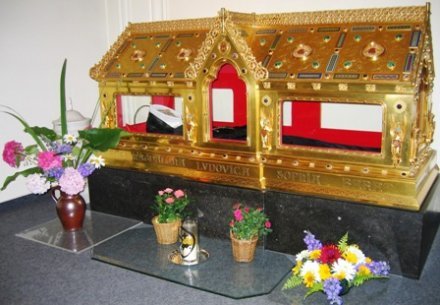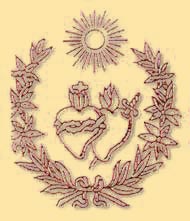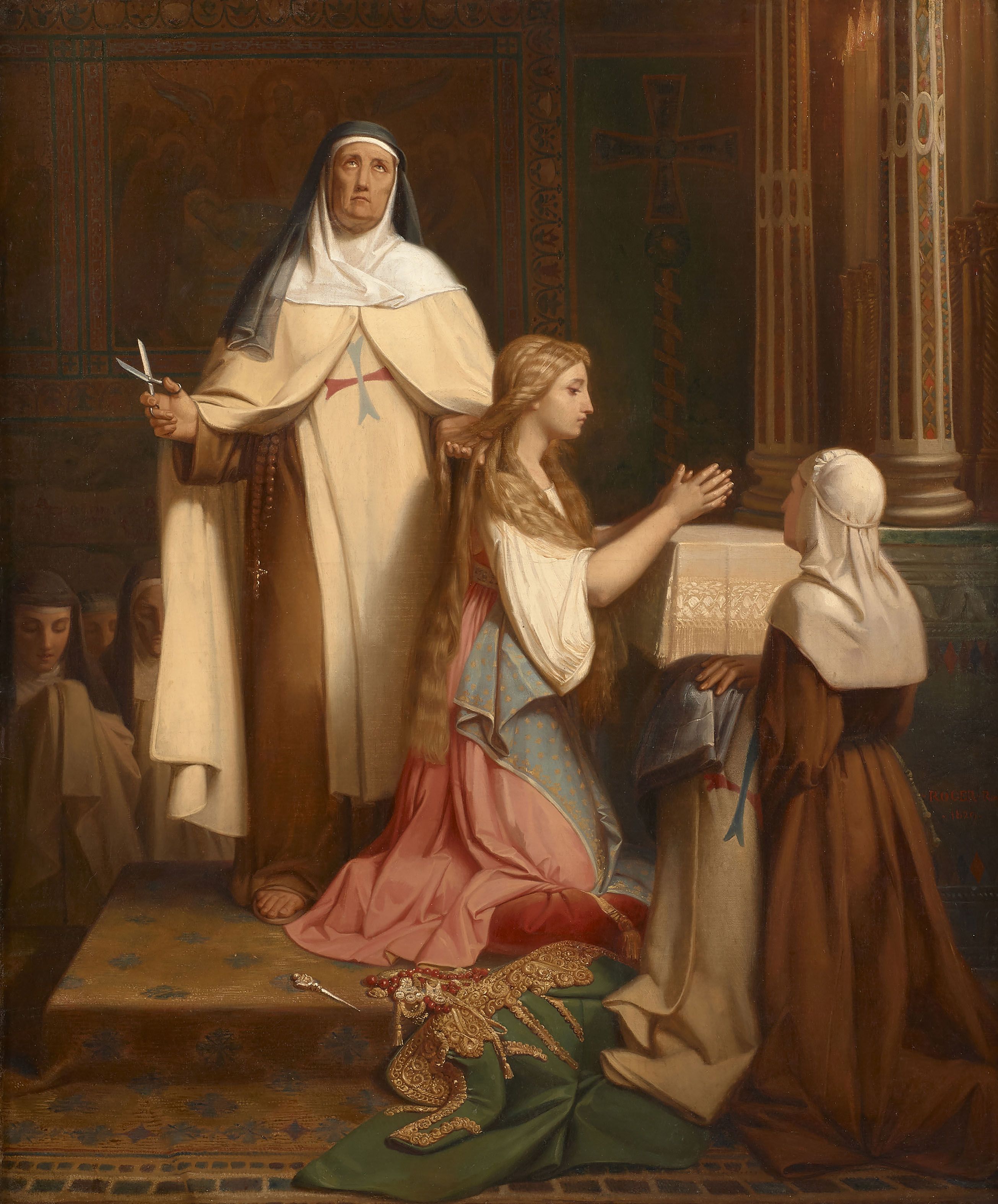|
Marie Joséphine Goetz
Marie Joséphine Goetz (7 March 1817 – 4 January 1874) was a French nun, the second superior-general of the Society of the Sacred Heart. Life From Alsace-Lorraine, Marie Joséphine was the daughter of Joseph Goetz of Strasbourg and Marie Anne Wagner. As her parents died when Goetz was still young, her education was left to the care of an aunt. The aunt sent her to school at the Convent of the Sacred Heart, Besançon. At the age of seventeen she entered the novitiate of the Sacred Heart at Montet and took her first religious vows in 1837. In 1842 she was entrusted with the charge of the school at Besançon, which was going through a difficult phase, and showed judicious management. Immediately after profession in 1847 she was appointed mistress of novices at Conflans, Charenton-le-Pont. Goetz continued in this charge, to which was afterwards added the government of the house as superior, until 1864, when she was named vicar-general. The failing strength of Superior-general ... [...More Info...] [...Related Items...] OR: [Wikipedia] [Google] [Baidu] |
Superior General (Christianity)
A superior general or general superior is the leader or head of an 'order' of religious persons (nuns, priests, friars, etc) or, in other words, of a 'religious institute' in the Catholic Church, and in some other Christian denominations. The superior general usually holds supreme 'executive' authority in the religious community, subject only to the Pope in the case of Catholic orders, while the general chapter has 'legislative' authority. Many Catholic superiors general are elected (directly or indirectly) by their order's membership, and are based in Rome, and thus facilitate their order's engagement with other elements of church leadership (the Pope; the Roman Curia; other orders' leadership). History The figure of superior general first emerged in the thirteenth century with the development of the centralized government of the Mendicant Orders. The Friars Minor (Franciscans) organized their members under a Minister General (Franciscan), Minister General, and the Order of Preac ... [...More Info...] [...Related Items...] OR: [Wikipedia] [Google] [Baidu] |
Charenton-le-Pont
Charenton-le-Pont () is a Communes of France, commune situated to the southeast of Paris, France. It is located from the Kilometre Zero, centre of Paris, to the north of the confluence of the Seine and Marne (river), Marne rivers; the part of the name refers to the stone bridge across the Marne. It is one of the most densely populated municipalities in Europe. The Charenton (asylum), Charenton Psychiatric Hospital is located in the neighbouring commune Charenton-Saint-Maurice, which changed its name in 1842 to Saint-Maurice, Val-de-Marne, Saint Maurice. History A Bronze Age hoard of weapons was found in the river Seine at Charenton in the late nineteenth century. Comprising swords, axes, spearheads and other miscellaneous objects, it is now in the British Museum. Charenton was always a point of importance for the defence of the capital, and was frequently the scene of bloody conflicts. The Fort de Charenton, fort of Charenton, located in Maisons-Alfort but intended to defend ... [...More Info...] [...Related Items...] OR: [Wikipedia] [Google] [Baidu] |
1817 Births
Events January–March * January 1 – Sailing through the Sandwich Islands, Otto von Kotzebue discovers New Year Island. * January 19 – An army of 5,423 soldiers, led by General José de San Martín, starts crossing the Andes from Argentina, to liberate Chile and then Peru. * January 20 – Ram Mohan Roy and David Hare found Hindu College, Calcutta, offering instructions in English on Western subjects, including other European languages. * February 12 – Battle of Chacabuco: Argentine and Chilean soldiers of the United Provinces of the Río de la Plata defeat the Spanish royalist troops in what is now Chile, marking the turning point in the war against European rule of South America. * March 3 ** On his last day in office, U.S. President James Madison vetoes John C. Calhoun's Bonus Bill as unconstitutional after it has passed both houses of the U.S. Congress. ** The U.S. Congress passes a law to split the Mississippi Territory, after Mis ... [...More Info...] [...Related Items...] OR: [Wikipedia] [Google] [Baidu] |
Laval, Mayenne
Laval () is a town in western France, about west-southwest of Paris, and the capital of the Mayenne departments of France, department. Its inhabitants are called ''Lavallois''. The commune of France, commune of Laval proper, without the metropolitan area, is the 7th most populous in the Pays de la Loire region and the 132nd in France.Téléchargement du fichier d'ensemble des populations légales en 2017 Institut national de la statistique et des études économiques, INSEE A part of the traditional provinces of France, province of Maine (province), Maine before the French Revolution, which now split between two departments, Mayenne and Sarthe, Laval also lies on the threshold of Brittany and is not far from Normandy and County of Anjou, Anjou. It was thus ... [...More Info...] [...Related Items...] OR: [Wikipedia] [Google] [Baidu] |
Franco-Prussian War
The Franco-Prussian War or Franco-German War, often referred to in France as the War of 1870, was a conflict between the Second French Empire and the North German Confederation led by the Kingdom of Prussia. Lasting from 19 July 1870 to 28 January 1871, the conflict was caused primarily by France's determination to reassert its dominant position in continental Europe, which appeared in question following the decisive Austro-Prussian War, Prussian victory over Austria in 1866. According to some historians, Prussian chancellor Otto von Bismarck deliberately provoked the French into declaring war on Prussia in order to induce four independent southern German states—Grand Duchy of Baden, Baden, Kingdom of Württemberg, Württemberg, Kingdom of Bavaria, Bavaria and Grand Duchy of Hesse, Hesse-Darmstadt—to join the North German Confederation. Other historians contend that Bismarck exploited the circumstances as they unfolded. All agree that Bismarck recognized the potential for new ... [...More Info...] [...Related Items...] OR: [Wikipedia] [Google] [Baidu] |
Sophie Barat
Madeleine Sophie Barat, RSCJ, (12 December 1779 – 25 May 1865), is a French saint of the Catholic Church who founded the Society of the Sacred Heart, a worldwide religious institute of educators. Early life and family Barat was born on the night of 12 December 1779, in Joigny, France, next door to a house fire at a neighbour’s home. The stress and the terror of the fire caused Sophie's mother, Madeleine Fouffé Barat (1740–1822), then pregnant with her third child, to go into labour. Born two months premature, Madeleine Sophie was considered so fragile that she was baptised early the next morning in Sainy Thibault Church, just a few yards from the Barat family home. Although her parents had arranged godparents in advance, there was no time to call them to the church and so at five o'clock on the morning of 13 December 1779, Louise-Sophie Cédor, a local woman on her way to early Mass, and Sophie's older brother, Louis, stood in as her godparents. Barat was born into a finan ... [...More Info...] [...Related Items...] OR: [Wikipedia] [Google] [Baidu] |
Vicar-general
A vicar general (previously, archdeacon) is the principal deputy of the bishop or archbishop of a diocese or an archdiocese for the exercise of administrative authority and possesses the title of local ordinary. As vicar of the bishop, the vicar general exercises the bishop's ordinary executive power over the entire diocese and, thus, is the highest official in a diocese or other particular church after the diocesan bishop or his equivalent in canon law. The title normally occurs only in Western Christian churches, such as the Latin Church of the Catholic Church and the Anglican Communion. Among the Eastern churches, the Mar Thoma Syrian Church of Kerala uses this title and remains an exception. The title for the equivalent officer in the Eastern churches is syncellus and protosyncellus. The term is used by many religious orders of men in a similar manner, designating the authority in the Order after its Superior General. Ecclesiastical structure In the Roman Catholic Ch ... [...More Info...] [...Related Items...] OR: [Wikipedia] [Google] [Baidu] |
Abbess
An abbess (Latin: ''abbatissa'') is the female superior of a community of nuns in an abbey. Description In the Catholic Church (both the Latin Church and Eastern Catholic), Eastern Orthodox, Coptic, Lutheran and Anglican abbeys, the mode of election, position, rights, and authority of an abbess correspond generally with those of an abbot. She must be at least 40 years old and have been a nun for 10 years. The age requirement in the Catholic Church has evolved over time, ranging from 30 to 60. The requirement of 10 years as a nun is only eight in Catholicism. In the rare case of there not being a nun with the qualifications, the requirements may be lowered to 30 years of age and five of those in an "upright manner", as determined by the superior. A woman who is of illegitimate birth, is not a virgin, has undergone non-salutory public penance, is a widow, or is blind or deaf, is typically disqualified for the position, saving by permission of the Holy See. The office is e ... [...More Info...] [...Related Items...] OR: [Wikipedia] [Google] [Baidu] |
Mistress Of Novices
In the Christian Church, a novice master or master of novices (), is a member of an institute of consecrated life who is responsible for the training and government of the novitiate in that institute. In religious institutes for women, the novice mistress, lat. ''Magistra noviciorum'', is the equivalent. Sometimes the person in this position is called the novice director or director of novices. The direction of the novices is reserved solely to the master of novices, under the authority of the major superiors. The master of novices must be a member of the institute; he must have taken perpetual vows and be legally appointed. The novice master is often assisted by a zelator (second or deputy novice master). The novice master's duty is to see that the time devoted to the period of the novitiate be passed in prayer, meditation, and the development of character through a study of the life of Jesus Christ and the saints, church history, the vows and the constitution of the institute. ... [...More Info...] [...Related Items...] OR: [Wikipedia] [Google] [Baidu] |
Society Of The Sacred Heart
The Society of the Sacred Heart of Jesus (; ), abbreviated RSCJ, is a Catholic centralized religious institute of consecrated life of pontifical right for women established in France by Madeleine Sophie Barat in 1800. History Madeleine Sophie Barat founded the Society of the Sacred Heart of Jesus in the wake of the French Revolution to provide educational opportunities for girls. The manner of life was to be simple without the prescribed austerities of the older orders, which would be incompatible with the work of education. In some houses the religious conducted just one school, but in several places, especially in the larger houses in cities there were at least two schools, a boarding school and a school for poor children. The first convent was opened at Amiens in 1801. In 1820 the French Government gave a run down property now known as Hotel Biron (current Rodin Museum) to the Society. Other houses were opened in Grenoble, Niort, Poitiers and Cuigniers. In 1826 the socie ... [...More Info...] [...Related Items...] OR: [Wikipedia] [Google] [Baidu] |
Solemn Vow
A solemn vow is a certain vow ("a deliberate and free promise made to God about a possible and better good") taken by an individual after completion of the novitiate in a Catholic religious institute. It is solemn insofar as the Church recognizes it as such, and is unique in that no human authority within the church can relieve a person from it. Distinction from simple vows Any vow in Catholic religious life other than a solemn vow is a simple vow. Even a vow accepted by a legitimate superior in the name of the Church (the definition of a "public vow") is a simple vow if the Church has not granted it recognition as a solemn vow. In canon law a vow is public (concerning the Church itself directly) only if a legitimate superior accepts it in the name of the Church; all other vows, no matter how much publicity is given to them, are classified as private vows (concerning directly only those who make them). The vow taken at profession as a member of any religious institute is a p ... [...More Info...] [...Related Items...] OR: [Wikipedia] [Google] [Baidu] |
Religious Vows
Religious vows are the public vows made by the members of religious communities pertaining to their conduct, practices, and views. In the Buddhist tradition, in particular within the Mahayana and Vajrayana traditions, many different kinds of religious vows are taken by the lay community as well as by the monastic community, as they progress along the path of their practice. In the monastic tradition of all schools of Buddhism, the Vinaya expounds the vows of the fully ordained Nuns and Monks. In the Christian tradition, such public vows are made by the religious cenobitic and eremitic of the Catholic Church, Lutheran Churches, Anglican Communion, and Eastern Orthodox Churches, whereby they confirm their public profession of the evangelical counsels of poverty, chastity, and obedience or Benedictine equivalent. The vows are regarded as the individual's free response to a call by God to follow Jesus Christ more closely under the action of the Holy Spirit in a particular form of ... [...More Info...] [...Related Items...] OR: [Wikipedia] [Google] [Baidu] |




